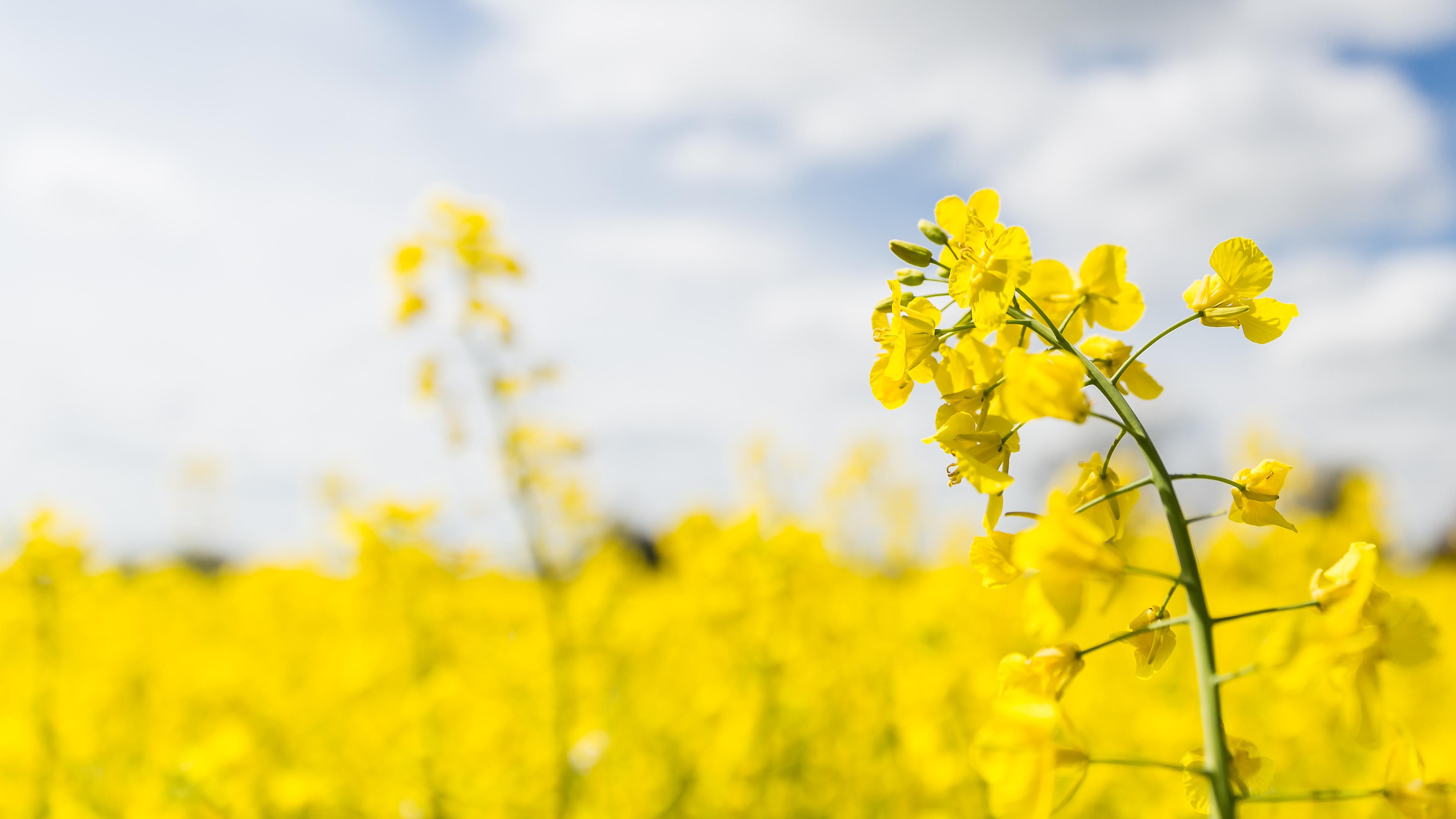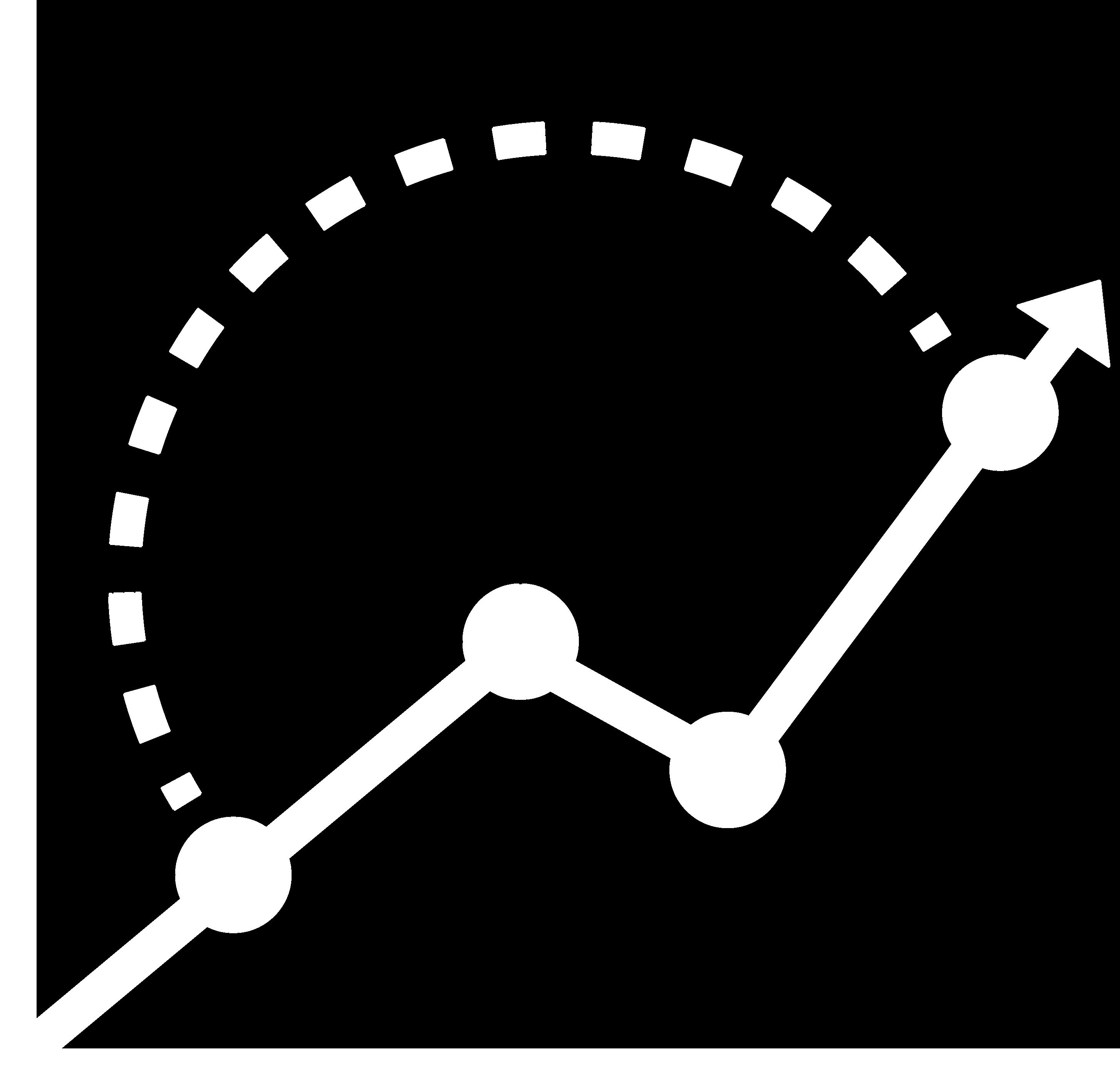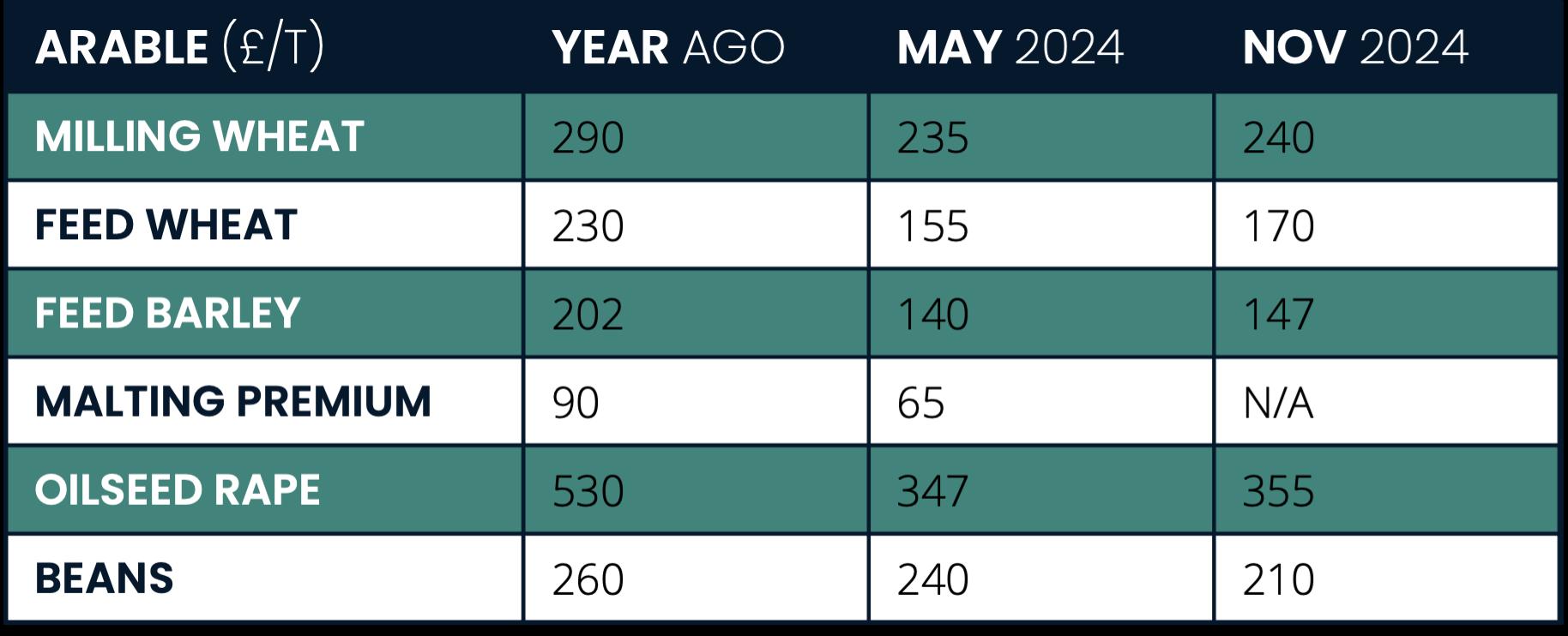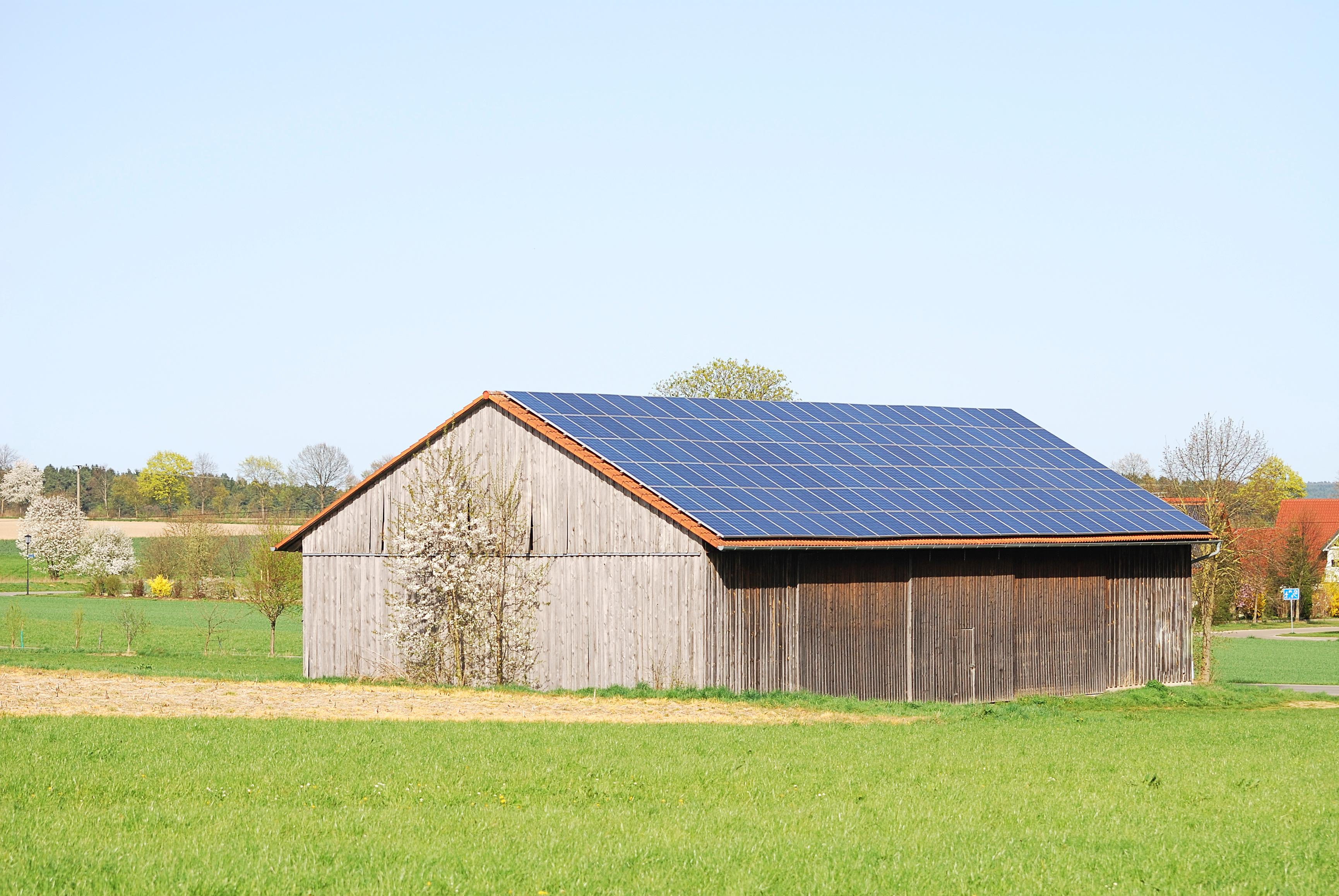FARMING UPDATE



MARCH 2024
Welcome to the Ceres Rural Farming Update, a publication that provides independent insights on agricultural issues, from policy and grant funding, to administrative updates and key market information.

Looking ahead to Harvest 2024, it is useful to get a picture of what crops were planned. The Early Bird Survey is a useful tool for indicating what is in the ground, however we all know that even if this is the case, it might not count for much! The survey is conducted in early November, and therefore, the reality can be a fair way off.
That said, even the data from November, outlined below, is starting to show the difficult situation which UK arable farmers are facing this harvest – a large reduction in winter cropped area and a large increase in spring cropped area. What a surprise!
What will also come as no surprise is the increased area in ‘arable fallow’. Although a definition for what qualifies as ‘arable fallow’ is somewhat elusive, it is likely representing an increased area taken out of production for wildlife options, as available through Countryside Stewardship and the Sustainable Farming Incentive. As a point of reference, the 2017 arable fallow area reported by Defra was 251Kha.
The table below shows the results of the Early Bird Survey conducted by AHDB.
MARCH 2024 2
INTRODUCTION
EARLYBIRDSURVEY
INTHEFIELD

*Crops included rye, triticale and mixed grains
**Crops included linseed and borage
***Crops included sugar beet, potatoes, vegetables, maize (33%) and temporary grass (20%)
Source: Defra, The Andersons Centre for the AHDB
INTHEFIELD EASTUPDATE
RAINFALL
It won’t come as a surprise to anyone that East Anglia continues to be incredibly wet. Using MetOffice data for East Anglia, 2023 received approximately 120mm more rain than the average 20 years prior. This totalled 734.50mm according to the MetOffice, however some local weather stations recorded over 900mm in 2023!
CERESRURAL CO UK 3

CEREALS

The favourable outlook for crop establishment detailed in our previous farming update is sadly a far cry from the current reality, following seismic rainfall over the past four months. Early drilling of winter cereals seems to have been the right call this season, with mature plants showing greater resilience to the torrid conditions. Crops drilled later into autumn/winter were significantly compromised due to seed bed quality, and a number of growers were unable to sow their planned area of winter cereals. This was demonstrated in the poll we ran across social media in November which showed that only 34% of participants were 100% drilled by November 1st , and 30% of participants were only 0-50% drilled at the same date.
At this stage, the window for winter cereal planting is now gone, and growers must look to plan B for unplanted areas. For the crops that are in the ground, there are some key assessments to make around grass weed pressure in the coming weeks. Much of the planted area was compromised in its residual herbicide programme, with some crops receiving no pre-emergence spray at all. Despite some good flushes pre-drilling this year, there will certainly be more grass to come, and growers and advisors should be vigilant in tackling the problem while plants are of a vulnerable size.
The winter torrent will have inevitably eroded the residual nitrogen supply in our soils, particularly on the sandier soil textures. As travelling conditions improve and soils begin to warm, growers should continue to prioritise their first application of nitrogen (and sulphur) fertiliser. Compromised crops with require all the help they can get to quickly generate green area and generate additional tillers. Growers may consider splitting their first application, coming back at the beginning of March for the remaining 30-50 kg/ha.
Growers on freer draining and well-drained soils will have already begun planting spring cereals. Given the handsome premiums available in 2023, we foresee spring barley taking the majority share of the spring cereal cropping in the area. These crops will need sufficient nitrogen early on to ensure shoot numbers and yield are not restricted, but not forgetting the risks of excess grain nitrogen when growing for the malting market.
4 MARCH 2024
BREAKCROPS

2024 has presented kinder conditions for oilseed rape growers than 2023. Crops were drilled into moisture in a timely fashion in the autumn, and the mild winter has staved off the crippling frost damage that occurred in 2023, so crops are looking well heading into the spring. It’s not all plain sailing though; there are still CSFB larvae to be found in most crops, and as the maize harvest and shooting season finishes, oilseed rape will become the number one food source for pigeons throughout February and March.
Being mindful of this, like cereals, oilseed rape crops will benefit from a much-needed early dose of nitrogen, helping plants grow away from the feeding damage they are currently experiencing. Light Leaf Spot is noticeably absent in many crops, and this may continue with a vigilant approach to fungicide application. The market is not offering growers any more excitement from 2023, but let’s hope there is more in the shed to sell than last year.
As is often the case, winter beans have once again fallen victim to their role as the poor relation to cereals. Where people did get brief sowing windows during the winter, in most instances it was the remaining wheat area that was prioritised. Where beans were drilled during breaks in the weather, they have coped remarkably well in marginal conditions, with even emergence noted amongst the majority of growers. In many instances, preemergence chemistry was not applied, meaning that grass-weed control will have undoubtedly been compromised.
5 CERESRURAL CO UK

SUGARBEET

It is fair to say that those who had an early lift for harvest 2023/2024 were probably at an advantage this season. After the change in weather at the beginning of October, harvesting became hugely challenging across the south and east. On the sands of Norfolk and Suffolk, or on the chalkier areas of Essex and Herts, some lifting was possible as scheduled, however most growers were significantly delayed. For many, the planting of winter wheat after their sugar beet will no longer be an option.
Despite this, yields look to be good across the growing region. Adequate moisture and a mild autumn meant that many crops maintained a healthy canopy which translated into good root yield. Sugars have been slightly underwhelming, not being helped by a lack of sunshine throughout the growing season.
After a turbulent negotiation period, British Sugar and NFU Sugar finally agreed a contract in December for the 2024/2025 growing season. The agreement presents growers with four options with varying levels of risk:
a £40 per tonne fixed price (as per the 2023/24 price) a core price of £38 per tonne plus a market-linked bonus a futures-linked option, for up to 35% of their contract yield protection at a £1 per tonne reduction on the core or fixed contract price.
With the current position of the combinable crop markets, sugar beet certainly looks the more profitable break crop option heading into 2024. Growers should now have seed on farm with a drilling window hopefully opening up in the coming weeks.
Once again, the use of ‘Cruiser SB’ neonicotinoid seed treatment for the control of Virus Yellows (VY) has been granted for use in the UK under emergency authorisation. It will only be used if the predicted virus incidence level is 65% or above, as determined on 1 March 2024 by the Rothamsted forecast. This is a decision that will continue to face environmental scrutiny. The BBRO continue to work closely with key stakeholders to find a longterm solution to the challenges posed by the virus.
6 MARCH 2024
INTHEFIELD WESTUPDATE
RAINFALL
Just like the rest of the country, the west has certainly had its fair share of rainfall in 2023, with up to 30% more than the 19902020 average in some parts of the region. Since the start of 2024 the conditions have been very unsettled and yet more rain has fallen, making saturated ground even wetter and more difficult to travel on. Let's hope thischangesheading into thespring.
CEREALS
The nature of the season has created huge challenges with drilling and establishing winter crops this season. There are large areas of the region with nothing in the ground, large areas of compromised looking crops, with only a small proportion looking as you would expect for this time of year. Where a pre-emergence herbicide was applied, the crops are looking relatively clean, however with a large area not receiving any herbicide yet, there are many weeds to contest with. These include ryegrass and number of broadleaved weeds , such as groundsel and cleavers. Where ryegrass or other problematic grassweeds are present, it is advised to apply a post emergence herbicide as soon as conditions allow to ensure they are targeted at smaller plants.
On lighter land some winter cereals are showing signs of manganese deficiency, and a foliar application would be well advised. Some clients are now thinking about applying fertiliser to backward crops and this would be an acceptable option – but resist applying when heavy rain is forecast as this could be a very costly application.
Conditions in the west will see a far higher proportion of spring planting than expected. This has created a high demand for seed, and growers will have to be proactive in their procurement and expect to pay an inflated price. As always, ensuring spring crops are drilled into optimal seed bed conditions will be the key to driving yield, giving the plants the best chance of establishment in the ever more volatile springs we are experiencing.
7 CERESRURAL CO UK


FORAGE
Silage yields in 2023 were strong, however quality was reduced in place, with conception rates of cattle being variable as a result. Maize yields were also strong in 2023, resulting in many farms growing a similar (if not more) amount of maize this year. It is important that seed orders are confirmed as soon as possible.
Grain maize is becoming increasingly common in large areas of the country and can be sold for two different markets – crimping and drying. Even with later harvests, reports suggest that the majority of crops were harvested in good condition despite the high rainfall during the harvesting months. With the recent SFI payment rates in mind, many growers are looking at alternative winter grazing options away from straight mixes or stubble turnips.
8 MARCH 2024

UPDATE LIVESTOCK
There is much happening in the livestock world at the moment. Earlier in the autumn, Blue Tongue was identified in two areas of Norfolk and Kent, both being placed under Temporary Control Zones (TCZs). Fortunately, those have now been lifted, with the cooler temperatures having slowed down the transmission and replication of the virus. It is disheartening to see the return of a disease not detected in the UK since 2017, with no vaccine against the BT3 strain of the virus currently being available.
Of more concern nationally, however, is another midge borne virus ‘Schmallenberg’ which, if a cow or ewe is infected in the first third of pregnancy, can result in deformed offspring. There have been reports of up to 50% of ewes affected in some early lambing flocks.
Meanwhile, there has been a welcome reduction in reports of Avian Influenza compared to this time last year. Milk prices are on the steady incline, and meat prices continue to rise across all sectors.
CERESRURAL CO UK
9

UPDATEMARKET
Since our autumn update, the market outlook can only be described as desperate. It will pain many of our readers to look at crop values this time last year, particularly growers of cereals for feed markets and oilseed rape.
With regards to feed wheat, the price has slumped a further £10/t since November 2023, with very little appetite for old crop being shown by the market. Many businesses will be desperate to clear sheds at this stage from both a cashflow and logistics perspective, but the below prices make a sale at this a bitter prospect, particularly when nitrogen was bought at approx. £2/kg for many of these crops. For those with the ability to do so, old crop will be carried forward with the hope that forward prices can be capitalised upon.
Oilseed rape prices continue to underwhelm at a time when the ability to grow the crop becomes ever more challenging. Our experience is that the stagnation in price has seen a number of loyal growers significantly reduce their grown area, or not plant at all for 2024. That said, there are still reasonable oil bonuses and premiums to be had, particularly for niche markets.

Amongst the gloom, some crops have maintained some reasonable value. Last year saw a lack of quality wheat entering the domestic market, and as a result there is still value in milling wheat at £240/t, a £10 increase on this time last year. Although generally yields were poor, bean prices have held firm, with growers realising prices of £240/t in recent months.
In the round, things are looking tight for 2024, even with the fertiliser market offering some respite with falling nitrogen prices. Global events do not seem to be stimulating the market in the way that we witnessed in 2022, and therefore, farmers will need to maximise efficiency and alternative income streams in the months ahead.

10 MARCH 2024
Source: Merchant East Anglia ex. farm bids (on 23rd Feb 2024)
NEWSPOLICY&BUSINESS
BIODIVERSITY NET GAIN
The 12th February marked the start of mandatory Biodiversity Net Gain for planning permissions in England. Unless an exemption applies, sites subject to planning permission will now need to demonstrate at least a 10% increase in the biodiversity value of the site in relation to the pre-development biodiversity value.
BNG was introduced by the Environment Act back in 2021, but the start of mandatory regulations marks a shift from the small, voluntary market to a nationwide marketplace for BNG units.
The statutory biodiversity metric is used to calculate the pre-development and postdevelopment biodiversity value of the development’s onsite habitat, as well as the value for any offsite biodiversity gains. It uses habitat information to generate “biodiversity units”, a proxy measure for biodiversity value. The statutory biodiversity metric data value inputs include habitat type, size, distinctiveness, condition, and its location.
For land managers interested in whether BNG would suit their business, Ceres Rural is able to provide a practical, high-level review of their land’s BNG potential. Our experts can assess the cost benefit analysis of creating a BNG scheme, whilst providing insightful comparisons surrounding the opportunities under Countryside Stewardship and the Sustainable Farming Incentive.
We can help identify land within your business that works best for BNG unit creation and can guide you through the options for creating BNG units – for example, the establishment and management of units yourself, or using a third party to establish and sell the units.
Our partnership with Ceres Property provides market leading expertise on the BNG market, helping to identify buyers for units and brokering deals with developers to help them unlock their planning permissions.
Whilst the introduction of BNG is not a surprise, nor is BNG a particularly new concept, we know for many landowners it still feels daunting and unfamiliar territory. So, if this is the case for you, know you are not alone, and know that should you need us, we are here to help guide you. No matter how far along your BNG journey you are, there is support Ceres Group can offer.

11 CERESRURAL CO UK

PAYMENTS
GRANTS&RURAL COUNTRYSIDESTEWARDSHIPSCHEME(CSS)

At the Oxford Farming Conference, Defra Minister Steve Barclay announced new payment rates for all new and existing Mid-Tier Countryside Stewardship agreements from 1st January 2024. On average, there has been a 10% increase in revenue rates. Existing agreement holders will realise this increase in their December 2024 payment. For some of the existing Stewardship options, the payment rates have increased by up to 200%, with species rich grassland options being particularly rewarded.
The minister also announced that there would be 50 new actions (formerly known as options) available across the Sustainable Farming Incentive and Countryside Stewardship, which will be accessible through a combined environmental land management offer in ‘the summer’. Despite some eye-catching payment rates for farming practices and water management, there is still very little detail of these options and how they will be added to existing agreements. Landowners and managers with river frontage should be ready to capitalise on the water management options, with payment rates of circa £1,000/ha.
CSS–CAPITALITEMS

In January 2023 on average, capital payment rates increased by 48% for agreements awarded on the 1st January 2023 or there after.
CSS capital options can be applied for as a standalone item throughout the year and applicants do not need to be in an environmental scheme to secure the funding. There are now 70 capital items available with an additional funding group recently introduced. The four group areas include:
Boundaries, trees, and orchards
Water quality
Air quality
Natural flood management
12
MARCH 2024
For 2024 there is no limit to the value of capital items that can be included in each of the four groups, however good value will need to be demonstrated.
Capital items which require support from Catchment Sensitive Farming (CSF) are now available in High, Medium and Low Priority Areas for Water and Air Quality. It would be advisable to contact your Local Catchment Sensitive Farming Officer promptly due to the expected increase in demand for funding.
Ceres Rural has helped many clients to utilise these grants, helping them make lifelong changes to the environmental position of their agricultural business.
CSSCAPITALONLYAPPLICATION CASESTUDIES
Mixed farming business awarded a grant of £97,000 to upgrade and improve an existing yard with new concrete, inspection pits and sediment traps.
Arable business awarded an £85,000 grant for hedge planting and coppicing, concrete yard renewal, sprayer washdown area and roofing, and new farm track.
Livestock business awarded a £68,620 grant for hedge planting, stock fencing, field gates and concrete for a livestock yard.
SUSTAINABLEFARMINGINCENTIVE(SFI)
SFI OFFER IN 2023
Since coming on stream on 18th September 2023, Ceres Rural has been busy enrolling farming businesses into the new SFI offering.
The 6 new standards in 2023 include:
Nutrient management standard
Integrated pest management standard
Hedgerows standard
Arable and horticultural land standard
Improved grassland standard
Low/no input grassland standard
CERESRURAL CO UK
13


Though at times there have been technical difficulties with the application process, we are generally seeing extremely quick turnarounds for agreement offers, with many applicants having been paid their first quarterly payment. As we head towards the mid-point of year one of some agreements, farmers and land managers should be considering the areas and and actions they would like to amend upon their annual declaration. As well as options within CSS, the SFI has also benefitted from increased payment rates for a number of actions, presenting it as a much more attractive offer for farming businesses.
SFI OFFER IN 2024
The SFI will also form part of the combined land management offer coming available in the summer. A raft of new actions has been proposed to facilitate precision and regenerative practices on farm. For existing agreement holders, there are two options for accessing these new actions:
Add new actions at your annual declaration date.
Apply for a new agreement at the point that these actions become available which runs parallel to your existing agreement.
The best approach for entering the SFI must be dealt with on a business-by-business basis, but there is certainly funding available to farmers today for actions which have very little impact on existing practices.
SUSTAINABLE FARMING SCHEME – WALES
The Sustainable Farming Scheme (SFS) in Wales has been announced through a number of consultations provided by the RPA to address the plans for the introduction of SFS and the reduction of BPS which will be gone by 2029.
The overall picture of the SFS was that it will be introduced by summer 2025. There will be 17 Universal Actions (UA’s) ranging from soil health planning to having good biosecurity on farm. All actions that are applicable to each specific farming enterprise will have to be applied as mandatory. The one eye-catching aspect of this new scheme is that at least 10% of each farm is managed as habitat and at least 10% has to be under tree cover as woodland or individual trees.
This will be a scheme to watch in the coming months and could be the start of a period of change and unrest for farmers in Wales.
14 MARCH 2024
NFUCONFERENCE GRANTANNOUNCEMENTS

2024 is already proving to be a turbulent year for farming across Europe. At the turn of the year, riotous scenes were witnessed on the continent, epitomised by events in Brussels, with the city centre choked by hundreds of dissatisfied farmers and their tractors. This wave of protests was born of growing mistrust in the Common Agricultural Policy dictated from the EU, and the seeming hypocrisy and injustice of cheap imports. Similar scenes were witnessed closer to home in recent weeks, with Welsh farmers airing their disdain for the direction the Welsh assembly has proposed for their future farming policy.
With these high-profile protests sending ripples through the English farming community, the NFU conference couldn’t come soon enough for the government. With a Prime Minister not addressing the conference since 2008, his presence this year gave Rishi Sunak the opportunity to diffuse rising tensions and state his government’s commitment to the industry and its communities. He was staunch in his commitment to the £4.2bn in the farming budget and its continued delivery to agriculture.
The headline announcement was the increase in the productivity and technology funding pot, rising from £91m last year to £220m for 2024. This will be available through the following schemes:
Farm Productivity Grant – this fund is designed to help farmers improve efficiencies and self-sufficiency with funding for robotics or on-roof solar.
Farming Equipment and Technology Fund – This is funding towards to cost of specialised equipment to assist in the following areas:
improve productivity manage slurry improve animal health and welfare
The government has announced the items available for the scheme, and the ability to apply will be open shortly.
15 CERESRURAL CO UK


FREEBUSINESSADVICE FUTUREFARMINGRESILIENCEFUND(FFRF)
If you have any questions about how the above topics could apply to your business, from implementing a new SFI scheme to calculating your carbon footprint, Ceres Rural is able to help free of charge, thanks to the Defra Future Farming Resilience Fund (FFRF).
The funding scheme only runs until March 2025, so it’s really important that you take up this opportunity to get free advice soon.
Until then, we continue to be able to carry out a range of consultancy services, guiding you through the main opportunities and challenges to consider, and helping you identify how to adapt your business to maximise its resilience in the new era.
Our diverse offering enables farmers to choose from one of the following services:
A farm resilience report or carbon audit
A benchmarking report or business plan
A new or follow up half day business review
Ceres Rural has already helped over 950 farm businesses in this round of the FFRF. The feedback is overwhelmingly positive – in a survey of participants:
80% agreed that their report supported them to be confident in making decisions during the Agricultural Transition
73% said it enabled them to improve their farming business
96% of respondents have made, or will make, changes on farm thanks to the report. The most popular changes cited are entering a new environmental scheme and applying for a new grant.
To understand more, you can read about how our free business advice is helping a Kent arable operation with its plans for a sustainable future: here, or just watch the video: here.
01223 679 679
REGISTERTODAY MARCH 2024 16 click here click here

HEALTH &SAFETY
The Farm Safety Foundation – affectionately known by many as Yellow Wellies –recently spearheaded their seventh annual Mind Your Head campaign which continued to raise awareness of the challenges posed by and tackle the stigmas associated with poor mental health in the farming sector. The UK farming industry has endured many recent challenges including increasing input costs, decreasing commodity prices, widespread flooding, crop failures and animals in danger. This year, Yellow Wellies produced a short film exploring the aftermath of suicide in a farming family, which can be viewed here: WAKE
Health and safety training is important in ensuring that people who work for you know how to work safely and without risks to health; developing a positive culture where safe and healthy working becomes second nature to everyone; and meeting your legal duty to protect the health and safety of your workers.The Health & Safety at Work etc. Act 1974 requires you to provide whatever information, instruction, training and supervision as is necessary to ensure, so far as is reasonably practicable, the health and safety at work of your employees. This is expanded by the Management of Health & Safety at Work Regulations 1999 which identify situations where health and safety training is particularly important, such as when people start work, on exposure to new or increased risks, and where existing skills may have become rusty or need updating. Before the onset of the busy spring period with drilling, spraying and fertilising operations on arable farms and calving and lambing on livestock farms, take time to decide what training your business needs, identify your training priorities, and choose your training methods and resources, deliver the training, and check that the training has achieved its objectives.
As the spring progresses, public rights of way that cross fields can easily be overlooked. Where land has been cultivated, public rights of way must be reinstated within 14 days if a crop is to be planted imminently, or within 24 hours in all other circumstances to the required width (one metre for footpaths and two metres for bridleways). Where livestock are being turned out, consider fields that have rights of way across them, whether public or permissive: be cautious of pregnant or recently calved cows and their young as well as bulls, ensure fences and gates are secure, appropriate signage is in place, and regular checks are made on grazing stock.
CERESRURAL CO UK 17

DATESFOR
THEDIARY
SUMO & JCB Cultivation Working Day – 13th March Near Royston (email claire.motyczak@ceresrural.co.uk to book your space)
On The Farm with Ceres Rural – 21st March, Near Takeley (email charlotte.button@ceresrural.co.uk to book your space)
High Easter Point-to-Point – 13th April
Oxon Young Farmers County Show – 18th May
Beds Young Farmers Rally – 18th May
Essex Young Farmers Show – 19th May
Suffolk Show – 31st May & 1st June
Cereals – 13th & 14th June
GETIN TOUCH
IIf you would like to discuss any of the topics covered in this issue of the Farming Update, do contact a member of the Team, or speak to the project leader, George Catchpole, via the details adjacent.

MARCH 2024
GEORGECATCHPOLE ASSOCIATE|SAFFRONWALDEN george catchpole@ceresrural co uk 07928 667 899
18





















